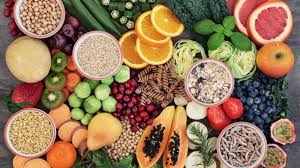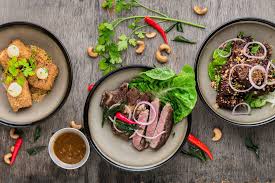
A menstrual diet is a diet that is followed during menstruation. It mainly aims to provide better nutrition during this time as well as reduce the intensity of pain. Healthy, well-balanced diet is essential to avoid painful times of the month.
According to a research by The Gynecology Center, Sweden, leafy vegetables can benefit the body during periods. In addition to being rich in iron and B-vitamins, their high fiber count can also help with digestive issues that are often associated with the menstrual cycle. Foods rich in good fats or omega-3s, such as almonds, can be helpful and more filling than junk food during menstrual periods. Fruit is another type of food that can relieve digestive problems associated with periods. Fiber in whole grains, like fruits, will help to remain regular during menstruation. Whole grains also contain carbohydrates, which provide important vitamins and minerals. It is necessary to increase the amount of iron during menstruation to compensate for the damage that occurs during each month. Iron helps to prevent anemia and the symptoms that go with it. Eating red meat helps in getting enough iron from food. For non-vegetarians, it is necessary to take an alternative supplement to maintain sufficient iron reserves.
Drinks with freshly baked cookies, high sodium content and other junk food should be avoided during this time as they may feel uncomfortable, bloating.
Read more:Reasons for long periods and what to consider for early periods
Use these food items in the limit
1. Alcohol: While alcohol may temporarily reduce cramps, increase estrogen levels, which can worsen menstrual symptoms.
2. Caffeinated Drinks: Reduce the amount of coffee – one of the main drinks you need to avoid during your period. This increases blood pressure and heart rate leading to stress and anxiety attacks and, in turn, worsens the symptoms of PMS.
3. Processed foods: Frozen foods, fast foods, bacon, pickles, canned soups, papads etc. come with unknown ingredients and preservatives that are not the best foods during your period. They can interfere with hormones and increase the discomfort of PMS.
4. Foods high in fat: Fatty foods affect hormones, cause cramps and can make you feel gassy. Given the fact that your skin is already sensitive these days, wrong food choices during your period can make the issue worse and may even become more dry and dehydrated.
5. Dairy Products: This may come as a surprise to you but it is not advisable to take dairy products like milk, cream and cheese. They are high in arachidonic acid which can act as an active for menstrual cramps.
6. Fried foods: It goes without saying – most fried foods like chips, snacks, biscuits, etc. contain trans-fat or hydrogenated vegetable oil. All of these can increase estrogen levels and spoil your mood.
7. Refined grains: Bread, pizza, cereals, and should be avoided as they cause bloating and constipation.
8.Foods with high salt content: Canned soups, bacon, chips, etc. should be avoided as they are high in salt. The hormones responsible for menstruation already cause water retention and a high salt diet will cause a grace, bloating.

Food items that you can easily consume
Whole Grains: Whole grains provide significant amounts of fiber, protein, and B vitamins – nutrients that improve hormonal balance and reduce symptoms of heavy menstruation. On the other hand high-glycemic carbohydrate sources, such as white bread and sweets, can worsen your symptoms.
Oily fish: Oily fish, such as salmon, mackerel, lake trout and herring, provide plenty of protein and healthy fats, which are also important for hormonal balance and generalized menstruation. Replace rich sources of saturated fat such as red meat, poultry and cheese with cured, roasted or steamed steamed fish. Saturated fat increases inflammation.
Linseed seeds for fiber: They also contain natural compounds of lignans that can help balance hormones including estrogen. Reserved grains also supply iron, which is important to replenish if you experience heavy menstrual bleeding. Your body loses iron through the blood, which can cause anemia.
Fruits and Vegetables: Antioxidants, obtaining abundant amounts of vitamin C and beta-carotene are also important for improving hormonal balance and menstrual health. For beta-carotene, eat sweet potatoes, carrots, melon, mangoes and sweet peppers. Top vitamin C sources include red bell peppers, citrus fruits, broccoli, strawberries and Brussels sprouts.
Read more:What is a menstrual cup? Methods and benefits of its use in periods
Spinach: When you’re menstruating, your iron levels may decrease, which is why cravings for iron-rich foods are common during this time. But instead of reaching for a cheeseburger, choose leafy greens like spinach, kale, collard greens to replenish your body’s iron supply.
Oranges: Calcium and vitamin D erase the symptoms of PMS. High levels of calcium can also reduce cramps, aches and pains, being a muscle relaxant.
Bananas: A banana is one of the best mood-enhancing foods you can eat, thanks to high doses of Vitamin B. They are rich in potassium and magnesium, too, which can reduce water retention and inflammation.
Watermelon: When craving sweets, arrive for a slice of fruit. Whole fruits provide you with all the nutrients needed to overcome weakness and fatigue.
Salmon: Salmon is the answer to all your menstrual troubles. It is rich in omega-3 fatty acids, which work to relax your muscles, relieve pain. You can also get your omega-3s from walnuts, avocado, pumpkin, and flax seed.
Broccoli: Broccoli contains all the nutrients that play a role in reducing the symptoms of PMS – magnesium, potassium, calcium, and vitamins A, C, B6, and E. Fill your plate to boost your mood, fight fatigue and fight depression.
Dark Chocolate: Dark chocolate is a good source of magnesium, which not only swings tempered mood, but it also helps in regulating serotonin – the happy hormone. To boost serotonin, go with chocolate that is 60% cocoa or more.
Read more:What is a menstrual cup? Methods and benefits of its use in periods
